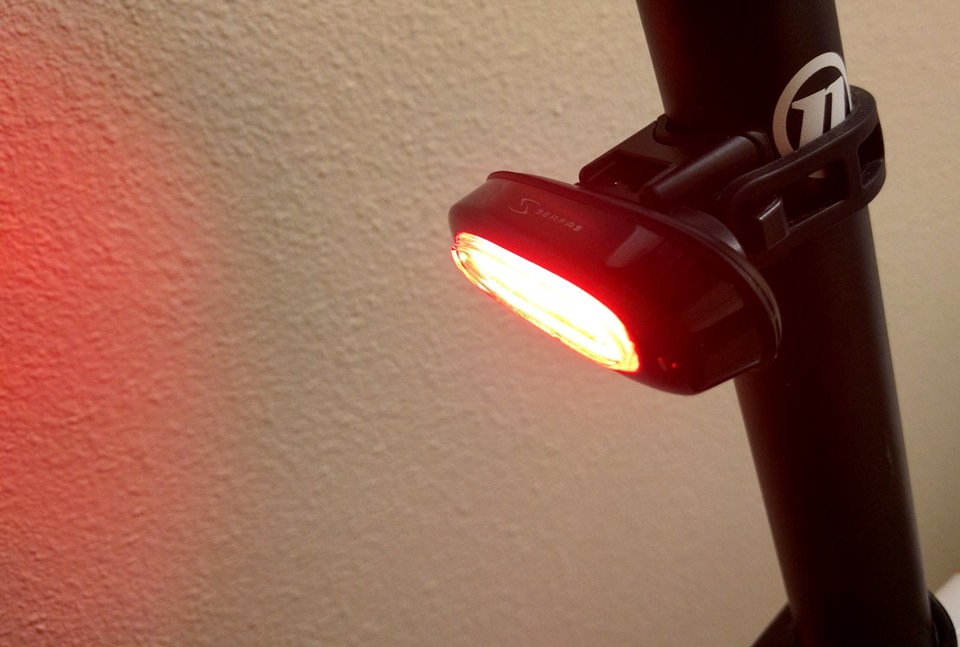
- 25 claimed lumens
- 2h 30min reported battery life
- Be-seen
- 46 g
- flashing mode
- no pulse mode
- 2 brightness levels
- Included mounts: Strap
The Quasar is a new low-cost safety/visibility light series from Serfas, similar to their mid-range Thunderbolt series but at a more affordable price point.
Series review: A low-cost take on Serfas' popular COB LED technology
Review by Nathan Hinkle, Feb. 29, 2016, 6 a.m.
The Quasar lights are use the same chip-on-board (COB) LEDs as Serfas' popular Thunderbolt series, but come with a lower output and runtime. These lights are meant to be a budget-friendly choice for people who may ride at night infrequently, or who are typically riding in areas without much car traffic where a bright light with long runtime isn't necessary.

I tested both the headlight and taillight version, which emit up to 70 and 25 lumens respectively. Both the front and rear lights are nearly identical besides their color and output. Thanks to the array of COB LEDs the Quasar is visible from a wide angle, although it does lack dedicated side lighting. Operation of the lights is very simple. A single button on the backside of the light cycles through high, low, and flashing modes. The flash is unremarkable – a slow and simple on/off which is unlikely to bother sensitive eyes at night, but is also not as eye-catching as some other lights.
The light does not appear to be compatible with Serfas' standard interchangeable taillight mount used by its other taillight series. The mount is simple, with a rubber strap holding a square plastic bracket in place on the bike. The light has a long clip which slides through the bracket. The symmetrical bracket allows for the light to be mounted vertically or horizontally; personally, I prefer the horizontal mounting direction. Unfortunately, there is no way to change the angle of the mounting bracket. For the headlight this is fine; you can just rotate the strap on the handlebars to adjust the position of the light. When mounted under the seatpost though it presents a problem – the light points towards the ground at whatever angle the seatpost is at. This significantly reduces the amount of light being shined towards traffic behind the bike. Serfas states that this was a design decision to keep the cost of the product down; personally, I think it significantly decreases the appeal of the taillight.
Neither light is very visible in direct sunlight; when I took them out on a bright day the COB LEDs were quickly washed out. This isn't an issue I've had with other COB lights like the Thunderbolt, and I think it can be attributed to the lower density of LEDs used in the Quasar. A dense grid of LEDs is required to produce a light which stands out in the daytime. At night the lights work reasonably well as safety visibility lights (other than the angling issues with the taillight). The headlight isn't really bright enough or focused enough to illuminate a dark street though, so if you're riding away from streetlights you'll want something brighter.

The Quasar taillight exceeded my expectations in one particular application: seat bags. Many people like to mount a taillight to their seat bag, particularly on road bikes. Problem is, until recently, most decent taillights used a focused circular lens which creates a tight beam. That narrow beam is very visible when oriented correctly, but brightness quickly drops off when seen from different angles. It's nearly impossible to keep such lights from flopping around on a seat bag, significantly reducing their effectiveness. The Quasar taillight has a large clip which facilitates mounting on a seat bag, and is light-weight so it won't flop around or droop towards the ground. The wide-angle COB LEDs don't form the same tightly focused beam, making the light visible even when the bag sways around. As previously mentioned, the battery life and visibility aren't adequate to use this light all day for daylight visibility, but the Quasar taillight is a great option for weight-conscious road bikers who aren't quite sure if they'll get home by dark.
Overall, the Quasar achieves what it set out to do: offer a low-cost rechargeable safety light. They aren't the best lights available, but they aren't trying to be, and they achieve their modest purpose well.